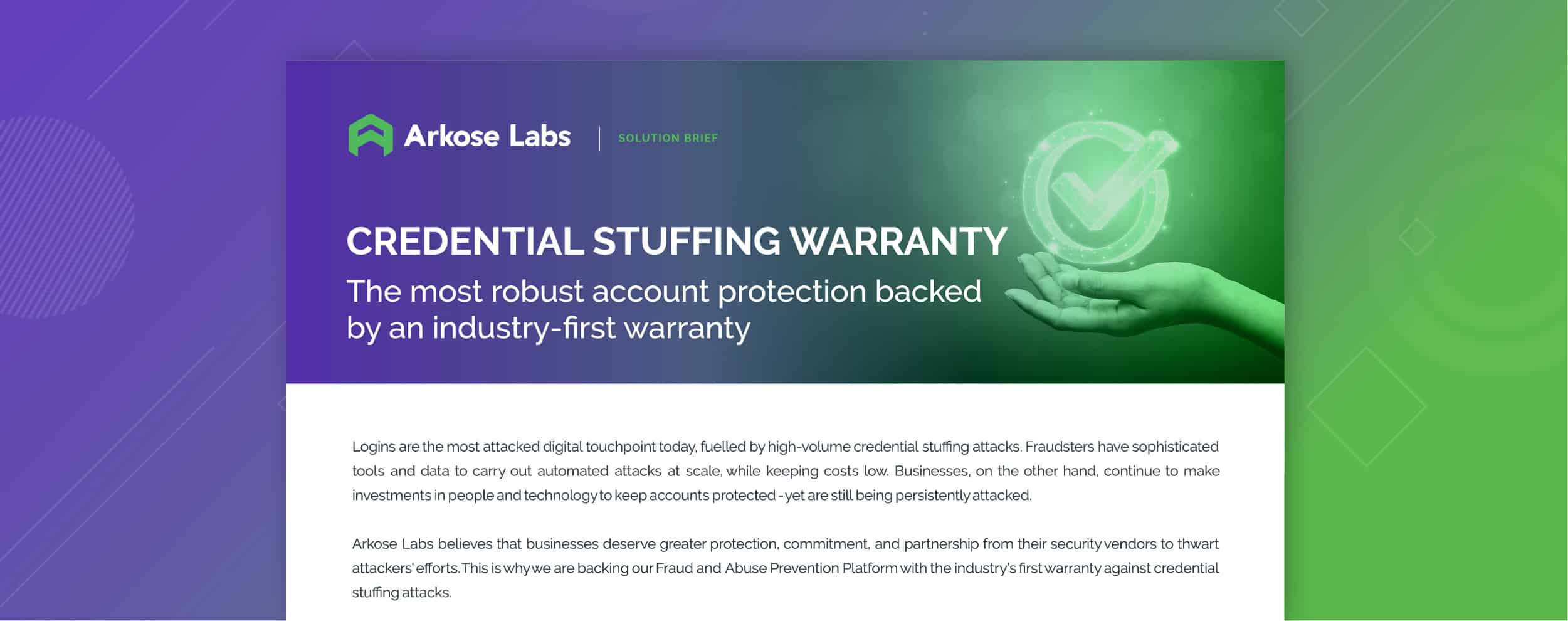Credential Theft and Prevention: What You Need to Know
While credential theft is not new, credential theft attacks are increasingly sophisticated, and even novice attackers have easy access to Cybercrime as a Service (CaaS) kits. As such, it is important to understand the methods used by attackers, examine its impact on businesses, and learn about the security measures critical to credential theft prevention.
Looking to understand the economic costs of credential stuffing attacks? Read our ebook:
What Is Credential Theft?
Credential theft refers to the theft of user credentials or corporate credentials to gain access to sensitive data or services. Credential theft attacks can happen through phishing emails, malware injection, brute-force attacks, social engineering, and many other ways. The most common types of credential theft involve usernames, passwords, and other authentication factors used to access internet websites and apps.
Criminals may use the stolen information themselves or sell it on the dark web, a hidden network on the internet that allows threat actors to conduct illegal activities without being traced. There’s a lot at stake when it comes to credential theft attacks, including identity theft, financial fraud, reputational damage, and many other downstream effects.
According to the 2022 Data Breach Investigations Report (DBIR): “Credentials are the favorite data type of criminal actors because they are so useful for masquerading as legitimate users on the system. Much like the proverbial wolf in sheep’s clothing, their actions appear innocuous until they attack.”1
The report goes on to say that there is a large resale market for stolen credentials, because those same credentials are used to perpetrate more cyberattacks. Therefore, it is critical that businesses take steps to protect themselves and their customers from the devastating consequences of credential theft.
How do credential theft attacks happen?
Credential theft can happen through various means, including a combination of the following:
- Phishing attacks
- Automated attacks
- Brute force attacks
- Social engineering
Phishing attacks
One way that credential theft happens is through a form of online identity theft known as phishing. Malicious actors often use fake emails and websites that look real to get sensitive information from unsuspecting victims. The attacker can then use this information to steal login credentials, credit card numbers, and other confidential data.
Automated attacks
One of the most common ways to steal credentials is through automated attacks that use malicious bots. Attackers use malicious software to gain access to a user’s credentials without their knowledge. Once installed in a system, this malware is a powerful tool for identity theft and other cybercrimes because it can record keystrokes, watch web activity, and even change system files without a user’s knowledge.
Brute force attacks
In brute force attacks, cybercriminals use automated programs to systematically guess passwords, usernames, and other credentials until they gain access to an account.
Credential stuffing is a type of brute-force attack that refers to the automated testing of username and password pairs obtained from the breach of another site.
Another type of brute-force attack is password spraying, a technique in which an attacker uses a single weak password against many different accounts on an application. Hackers will use automated tools to try these passwords on many different accounts, allowing them to gain access quickly.
Arkose Labs $1 Million Credential Stuffing Warranty Guarantees Success Against Volumetric Credential Stuffing Attacks:
Social Engineering
Attackers use social engineering to convince users or employees to give up private or sensitive information. Social engineering is often done through email, social media, or other forms of contact that make the victim feel rushed or scared. This makes them more likely to give up important information, click on a harmful link, or open a harmful file right away. Businesses may find it difficult to stop social engineering attacks because they depend on people, just like phishing attempts.
What is the business impact of credential theft?
It would be bad enough if stolen credentials were used once to drain a bank account or steal critical data. But the deleterious downstream effects of credential theft attacks are much broader and longer-lasting than a single episode. Stolen credentials can be used to:
- Drain stolen accounts, or make purchases.
- Access information such as credit card numbers, patient records, private messages, pictures, or documents which then can be used repeatedly for financial gain.
- Access an account to send phishing messages or spam in order to perpetuate the cycle of cybercrime.
Additionally, stolen credentials are often sold to other criminals, who then use them to exploit vulnerabilities and break into more systems. Financial losses can be high enough to ruin a business.
Credential theft attacks can also seriously damage a company’s reputation when customer data falls into the wrong hands, which can lead to fewer loyal customers and bad press.
Suffice to say, credential theft is the crime that keeps on taking, long after the credentials are stolen.
What is credential theft prevention?
Businesses can begin credential theft prevention by adopting multifactor authentication solutions, enforcing strong password policies, and providing security awareness training so employees can recognize threats and report them. A robust bot mitigation solution, like the one offered by Arkose Labs, may also be a critical piece of an overall credential theft prevention strategy to challenge automated and human-led attacks at the front door before they gain a foothold in your systems.
Password policies & authentication protocols
To prevent credential theft, organizations could implement strong authentication protocols, such as two-factor authentication (2FA) or multi-factor authentication (MFA). 2FA requires users to provide two pieces of information, such as a username and password or a security code sent via SMS or email. MFA requires multiple pieces of information, including biometric data such as fingerprint scans, making it more secure than nothing, but even MFA is not infallible. Cybercriminals use Man in the Middle” (MITM) toolkits to mirror target websites to users while extracting credentials like MFA tokens and session cookies in transit. The MITM phishing kits also automate the harvesting of two-factor authenticated (2FA) sessions. The Arkose Labs platform uses dynamic enforcement to prevent bots from abusing MFA. In addition to robust authentication protocols, organizations should implement password policies that require regular password changes, ban weak passwords, and require adequately complex passwords.
Monitor & analyze logins and traffic
Another way to prevent credential theft is to monitor and analyze logins and network traffic. Software solutions like intrusion detection systems (IDS) can alert you when suspicious activity is detected, helping to prevent potential data breaches. Analyzing user login patterns can also help identify anomalous behavior, which may be indicative of possible malicious activity. The Arkose Labs platform offers a unique combination of real-time risk assessments, machine learning analytics, transparent risk insights, and powerful attack response. Our customers can choose between invisible risk assessments through Arkose Detect, or full-spectrum detection and response, through Arkose Protect.
Conclusion
Credential theft attacks affect both individuals and businesses. Attackers can gain access to sensitive information through various means, including phishing, automated attacks, brute force attacks, and social engineering. The impact of credential theft attacks on businesses can be devastating, leading to reputational damage, financial loss, and customer loss. The stolen information can also be sold to other criminals, which perpetuates the cycle of cybercrime.
Credential theft prevention measures may include MFA solutions, strong password policies, security awareness training for employees, and implementing a robust bot mitigation solution. While strong authentication protocols like 2FA and MFA can help, they are not infallible, and businesses should consider a solution like Arkose Labs that provides dynamic challenges to malicious bots used in credential theft attacks.
By being proactive, businesses can reduce the chance of becoming victims of credential theft and protect their customers’ sensitive data.
*** This is a Security Bloggers Network syndicated blog from Arkose Labs authored by Prashant Nirmal. Read the original post at: https://www.arkoselabs.com/blog/credential-theft-and-prevention/







